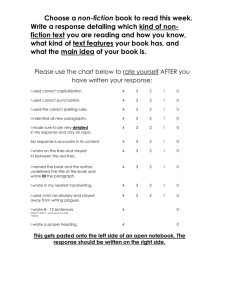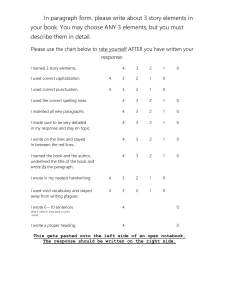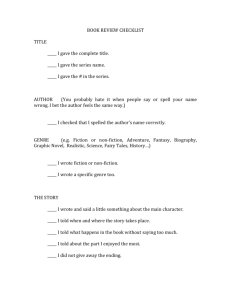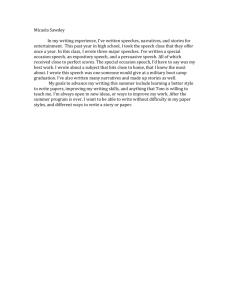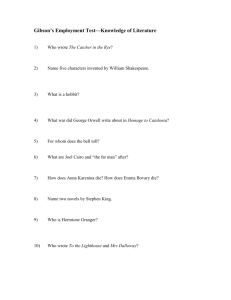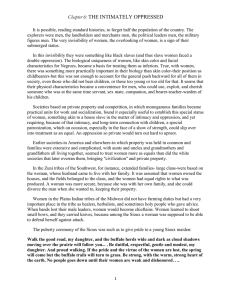The Intimately Oppressed - School District of New Richmond
advertisement
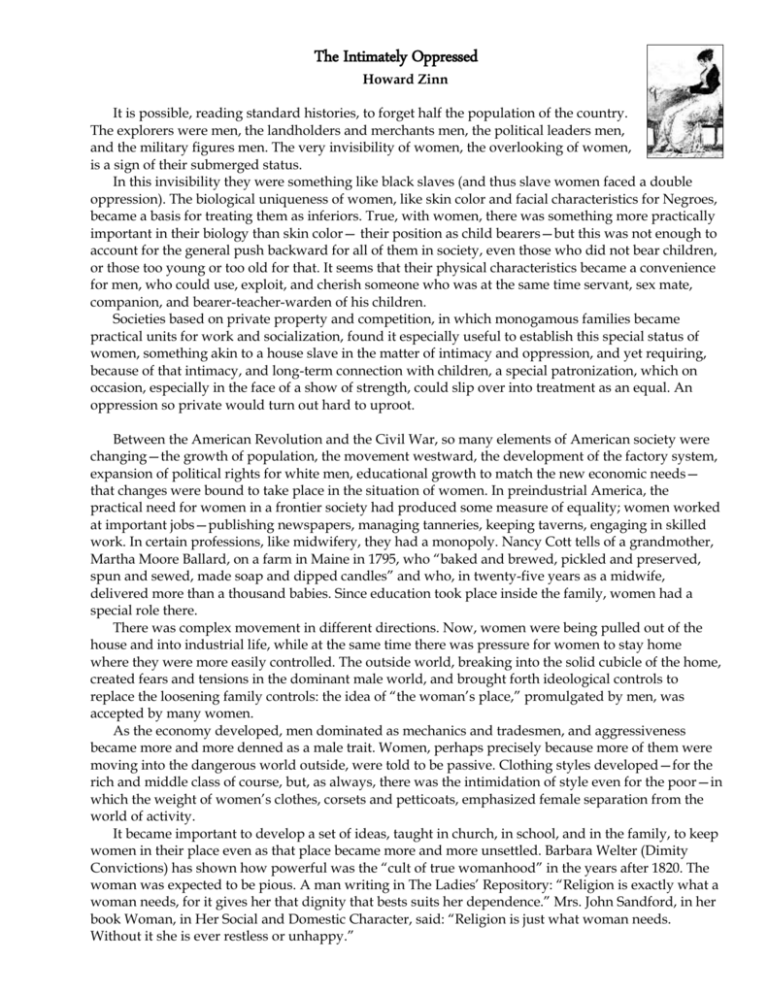
The Intimately Oppressed Howard Zinn It is possible, reading standard histories, to forget half the population of the country. The explorers were men, the landholders and merchants men, the political leaders men, and the military figures men. The very invisibility of women, the overlooking of women, is a sign of their submerged status. In this invisibility they were something like black slaves (and thus slave women faced a double oppression). The biological uniqueness of women, like skin color and facial characteristics for Negroes, became a basis for treating them as inferiors. True, with women, there was something more practically important in their biology than skin color— their position as child bearers—but this was not enough to account for the general push backward for all of them in society, even those who did not bear children, or those too young or too old for that. It seems that their physical characteristics became a convenience for men, who could use, exploit, and cherish someone who was at the same time servant, sex mate, companion, and bearer-teacher-warden of his children. Societies based on private property and competition, in which monogamous families became practical units for work and socialization, found it especially useful to establish this special status of women, something akin to a house slave in the matter of intimacy and oppression, and yet requiring, because of that intimacy, and long-term connection with children, a special patronization, which on occasion, especially in the face of a show of strength, could slip over into treatment as an equal. An oppression so private would turn out hard to uproot. Between the American Revolution and the Civil War, so many elements of American society were changing—the growth of population, the movement westward, the development of the factory system, expansion of political rights for white men, educational growth to match the new economic needs— that changes were bound to take place in the situation of women. In preindustrial America, the practical need for women in a frontier society had produced some measure of equality; women worked at important jobs—publishing newspapers, managing tanneries, keeping taverns, engaging in skilled work. In certain professions, like midwifery, they had a monopoly. Nancy Cott tells of a grandmother, Martha Moore Ballard, on a farm in Maine in 1795, who “baked and brewed, pickled and preserved, spun and sewed, made soap and dipped candles” and who, in twenty-five years as a midwife, delivered more than a thousand babies. Since education took place inside the family, women had a special role there. There was complex movement in different directions. Now, women were being pulled out of the house and into industrial life, while at the same time there was pressure for women to stay home where they were more easily controlled. The outside world, breaking into the solid cubicle of the home, created fears and tensions in the dominant male world, and brought forth ideological controls to replace the loosening family controls: the idea of “the woman’s place,” promulgated by men, was accepted by many women. As the economy developed, men dominated as mechanics and tradesmen, and aggressiveness became more and more denned as a male trait. Women, perhaps precisely because more of them were moving into the dangerous world outside, were told to be passive. Clothing styles developed—for the rich and middle class of course, but, as always, there was the intimidation of style even for the poor—in which the weight of women’s clothes, corsets and petticoats, emphasized female separation from the world of activity. It became important to develop a set of ideas, taught in church, in school, and in the family, to keep women in their place even as that place became more and more unsettled. Barbara Welter (Dimity Convictions) has shown how powerful was the “cult of true womanhood” in the years after 1820. The woman was expected to be pious. A man writing in The Ladies’ Repository: “Religion is exactly what a woman needs, for it gives her that dignity that bests suits her dependence.” Mrs. John Sandford, in her book Woman, in Her Social and Domestic Character, said: “Religion is just what woman needs. Without it she is ever restless or unhappy.” Sexual purity was to be the special virtue of a woman. It was assumed that men, as a matter of biological nature, would sin, but woman must not surrender. As one male author said: “If you do, you will be left in silent sadness to bewail your credulity, imbecility, duplicity, and premature prostitution.” A woman wrote that females would get into trouble if they were “high spirited not prudent.” The role began early, with adolescence. Obedience prepared the girl for submission to the first proper mate. Barbara Welter describes this: The assumption is twofold: the American female was supposed to be so infinitely lovable and provocative that a healthy male could barely control himself when in the same room with her, and the same girl, as she “comes out” of the cocoon of her family’s protectiveness, is so palpitating with undirected affection, so filled to the brim with tender feelings, that she fixes her love on the first person she sees. She awakes from the midsummer night’s dream of adolescence, and it is the responsibility of her family and society to see that her eyes fall on a suitable match and not some clown with the head of an ass. They do their part by such restrictive measures as segregated (by sex and/or class) schools, dancing classes, travel, and other external controls. She is required to exert the inner control of obedience! The combination forms a kind of societal chastity belt, which is not unlocked until the marriage partner has arrived, and adolescence is formally over. When Amelia Bloomer in 1851 suggested in her feminist publication that women wear a kind of short skirt and pants, to free themselves from the encumbrances of traditional dress, this was attacked in the popular women’s literature. One story has a girl admiring the “bloomer” costume, but her professor admonishes her that they are “only one of the many manifestations of that wild spirit of socialism and agrarian radicalism which is at present so rife in our land.” In The Young Lady’s Book of 1830: “ . . . in whatever situation of life a woman is placed from her cradle to her grave, a spirit of obedience and submission, pliability of temper, and humility of mind, are required from her.” And one woman wrote, in 1850, in the book Greenwood Leaves: “True feminine genius is ever timid, doubtful, and clingingly dependent; a perpetual childhood.” Another book, Recollections of a Southern Matron: “If any habit of his annoyed me, I spoke of it once or twice, calmly, then bore it quietly.” Giving women “Rules for Conjugal and Domestic Happiness,” one book ended with: “Do not expect too much.” The woman’s job was to keep the home cheerful, maintain religion, be nurse, cook, cleaner, seamstress, and flower arranger. A woman shouldn’t read too much, and certain books should be avoided. When Harriet Martineau, a reformer of the 1830s, wrote Society in America, one reviewer suggested it be kept away from women: “Such reading will unsettle them for their true station and pursuits, and they will throw the world back again into confusion.” A sermon preached in 1808 in New York: How interesting and important are the duties devolved on females as wives ... the counsellor and friend of the husband; who makes it her daily study to lighten his cares, to soothe his sorrows, and to augment his joys; who, like a guardian angel, watches over his interests, warns him against dangers, comforts him under trials; and by her pious, assiduous, and attractive deportment, constantly endeavors to render him more virtuous, more useful, more honourable, and more happy. Women were also urged, especially since they had the job of educating children, to be patriotic. One women’s magazine offered a prize to the woman who wrote the best essay on “How May an American Woman Best Show Her Patriotism.” It was in the 1820s and 1830s, Nancy Cott tells us (The Bonds of Womanhood), that there was an outpouring of novels, poems, essays, sermons, and manuals on the family, children, and women’s role. The world outside was becoming harder, more commercial, more demanding. In a sense, the home carried a longing for some Utopian past, some refuge from immediacy. Perhaps it made acceptance of the new economy easier to be able to see it as only part of life, with the home a haven. In 1819, one pious wife wrote: “ . . . the air of the world is poisonous. You must carry an antidote with you, or the infection will prove fatal.” All this was not, as Cott points out, to challenge the world of commerce, industry, competition, capitalism, but to make them more palatable. The cult of domesticity for the woman was a way of pacifying her with a doctrine of “separate but equal”—giving her work equally as important as the man’s, but separate and different. Inside that “equality” there was the fact that the woman did not choose her mate, and once her marriage took place, her life was determined. One girl wrote in 1791: “The die is about to be cast which will probably determine the future happiness or misery of my life.... I have always anticipated the event with a degree of solemnity almost equal to that which will terminate my present existence.” Marriage enchained, and children doubled the chains. One woman, writing in 1813: “The idea of soon giving birth to my third child and the consequent duties I shall be called to discharge distresses me so I feel as if I should sink.” This despondency was lightened by the thought that something important was given the woman to do: to impart to her children the moral values of self-restraint and advancement through individual excellence rather than common action. The new ideology worked; it helped to produce the stability needed by a growing economy. But its very existence showed that other currents were at work, not easily contained. And giving the woman her sphere created the possibility that she might use that space, that time, to prepare for another kind of life. The “cult of true womanhood” could not completely erase what was visible as evidence of woman’s subordinate status: she could not vote, could not own property; when she did work, her wages were one-fourth to one-half what men earned in the same job. Women were excluded from the professions of law and medicine, from colleges, from the ministry. Putting all women into the same category—giving them all the same domestic sphere to cultivate— created a classification (by sex) which blurred the lines of class, as Nancy Cott points out. However, forces were at work to keep raising the issue of class. Samuel Slater had introduced industrial spinning machinery in New England in 1789, and now there was a demand for young girls—literally, “spinsters”— to work the spinning machinery in factories. In 1814, the power loom was introduced in Waltham, Massachusetts, and now all the operations needed to turn cotton fiber into cloth were under one roof. The new textile factories swiftly multiplied, with women 80 to 90 percent of their operatives— most of these women between fifteen and thirty. Some of the earliest industrial strikes took place in these textile mills in the 1830s. Eleanor Flexner (A Century of Struggle) gives figures that suggest why: women’s daily average earnings in 1836 were less than 37 Vi cents, and thousands earned 25 cents a day, working twelve to sixteen hours a day. In Pawtucket, Rhode Island, in 1824, came the first known strike of women factory workers; 202 women joined men in protesting a wage cut and longer hours, but they met separately. Four years later, women in Dover, New Hampshire, struck alone. And in Lowell, Massachusetts, in 1834, when a young woman was fired from her job, other girls left their looms, one of them then climbing the town pump and making, according to a newspaper report, “a flaming Mary Wollstonecraft speech on the rights of women and the iniquities of the ‘moneyed aristocracy’ which produced a powerful effect on her auditors and they determined to have their own way, if they died for it.” A journal kept by an unsympathetic resident of Chicopee, Massachusetts, recorded an event of May 2, 1843: Great turnout among the girls . . . after breakfast this morning a procession preceded by a painted window curtain for a banner went round the square, the number sixteen. They soon came past again . . . then numbered forty-four. They marched around a while and then dispersed. After dinner they sallied forth to the number of forty-two and marched around to Cabot. . They marched around the streets doing themselves no credit. . There were strikes in various cities in the 1840s, more militant than those early New England “turnouts,” but mostly unsuccessful. A succession of strikes in the Allegheny mills near Pittsburgh demanded a shorter workday. Several times in those strikes, women armed with sticks and stones broke through the wooden gates of a textile mill and stopped the looms. Catharine Beecher, a woman reformer of the time, wrote about the factory system: Let me now present the facts I learned by observation or inquiry on the spot. I was there in midwinter, and every morning I was awakened at five, by the bells calling to labor. The time allowed for dressing and breakfast was so short, as many told me, that both were performed hurriedly, and then the work at the mill was begun by lamplight, and prosecuted without remission till twelve, and chiefly in a standing position. Then half an hour only allowed for dinner, from which the time for going and returning was deducted. Then back to the mills, to work till seven o’clock. ... It must be remembered that all the hours of labor are spent in rooms where oil lamps, together with from 40 to 80 persons, are exhausting the healthful principle of the air ... and where the air is loaded with particles of cotton thrown from thousands of cards, spindles, and looms. And what about the life of upper-class women? Frances Trollope, an Englishwoman, in her book Domestic Manners of the Americans, wrote: Let me be permitted to describe the day of a Philadelphian lady of the first class . . .. This lady shall be the wife of a senator and a lawyer in the highest repute and practice.... She rises, and her first hour is spent in the scrupulously nice arrangement of her dress; she descends to her parlor, neat, stiff, and silent; her breakfast is brought in by her free black footman; she eats her fried ham and her salt fish, and drinks her coffee in silence, while her husband reads one newspaper, and puts another under his elbow; and then perhaps, she washes the cups and saucers. Her carriage is ordered at eleven; till that hour she is employed in the pastry room, her snow-white apron protecting her mouse-colored silk. Twenty minutes before her carriage should appear, >he retires to her chamber, as she calls it; shakes and folds up her still snow-white apron, smooths her rich dress, and . . . sets on her elegant bonnet then walks downstairs, just at the moment that her free black coachman announces to her free black footman that the carriage waits. She steps into t, and gives the word: “Drive to the Dorcas Society.” At Lowell, a Female Labor Reform Association put out a series of “Factory Tracts.” The first was entitled “Factory Life as It Is By an Operative” and spoke of the textile mill women as “nothing more nor less than slaves in every sense of the word! Slaves, to a system of labor which requires them to toil from five until seven o’clock, with one hour only to attend to the wants of nature—slaves to the will and requirements of the ‘powers that be.’ . . .” In 1845, the New York Sun carried this item: “Mass Meeting of Young Women”—We are requested to call the attention of the young women of the city engaged in industrious pursuits to the call for a mass meeting in the Park this afternoon at 4 o’clock. We are also requested to appeal to the gallantry of the men of this city ... and respectfully ask them not to be present at this meeting as those for whose benefit it is called prefer to deliberate by themselves. Around that time, the New York Herald carried a story about “700 females, generally of the most interesting state and appearance,” meeting “in their endeavor to remedy the wrongs and oppressions under which they labor.” The Herald editorialized about such meetings: “ . . . we very much doubt whether it will terminate in much good to female labor of any description. ... All combinations end in nothing.” The title of Nancy Colt’s book The Bonds of Womanhood reflects her double view of what was happening to women in the early nineteenth century. They were trapped in the bonds of the new ideology of “women’s sphere” in the home, and, when forced out to work in factories, or even in middle-class professions, found another kind of bondage. On the other hand, these conditions created a common consciousness of their situation and forged bonds of solidarity among them. Middle-class women, barred from higher education, began to monopolize the profession of primary-school teaching. As teachers, they read more, communicated more, and education itself became subversive of old ways of thinking. They began to write for magazines and newspapers, and started some ladies’ publications. Literacy among women doubled between 1780 and 1840. Women became health reformers. They formed movements against double standards in sexual behavior and the victimization of prostitutes. They joined in religious organizations. Some of the most powerful of them joined the antislavery movement. So, by the time a clear feminist movement emerged in the 1840s, women had become practiced organizers, agitators, and speakers. When Emma Willard addressed the New York legislature in 1819 on the subject of education for women, she was contradicting the statement made just the year before by Thomas Jefferson (in a letter) in which he suggested women should not read novels “as a mass of trash” with few exceptions. “For a like reason, too, much poetry should not be indulged.” Female education should concentrate, he said, on “ornaments too, and the amusements of life . . .. These, for a female, are dancing, drawing, and music.” Emma Willard told the legislature that the education of women “has been too exclusively directed to fit them for displaying to advantage the charms of youth and beauty.” The problem, she said, was that “the taste of men, whatever it might happen to be, has been made into a standard for the formation of the female character.” Reason and religion teach us, she said, that “we too are primary existences . . . not the satellites of men.” In 1821, Willard founded the Troy Female Seminary, the first recognized institution for the education of girls. She wrote later of how she upset people by teaching her students about the human body: Mothers visiting a class at the Seminary in the early thirties were so shocked at the sight of a pupil drawing a heart, arteries and veins on a blackboard to explain the circulation of the blood, that they left the room in shame and dismay. To preserve the modesty of the girls, and spare them too frequent agitation, heavy paper was pasted over the pages in their textbooks, which depicted the human body. Women struggled to enter the all-male professional schools. Dr. Harriot Hunt, a woman physician who began to practice in 1835, was twice refused admission to Harvard Medical School. But she carried on her practice, mostly among women and children. She believed strongly in diet, exercise, hygiene, and mental health. She organized a Ladies Physiological Society in 1843 where she gave monthly talks. She remained single, defying convention here too. Elizabeth Blackwell got her medical degree in 1849, having overcome many rebuffs before being admitted to Geneva College. She then set up the New York Dispensary for Poor Women and Children “to give to poor women an opportunity of consulting physicians of their own sex.” In her first Annual Report, she wrote: My first medical consultation was a curious experience. In a severe case of pneumonia in an elderly lady I called in consultation a kind-hearted physician of high standing . . .. This gentleman, after seeing the patient, went with me into the parlour. There he began to walk about the room in some agitation, exclaiming, “A most extraordinary case! Such a one never happened to me before; I really do not know what to do!” I listened in surprise and much perplexity, as it was a clear case of pneumonia and of no unusual degree of danger, until at last I discovered that his perplexity related to me, not to the patient, and to the propriety; of consulting with a lady physician! Oberlin College pioneered in the admission of women. But the first girl admitted to the theology school there, Antoinette Brown, who graduated in 1850, found that her name was left off the class list. With Lucy Stone, Oberlin found a formidable resister. She was active in the peace society and in antislavery work, taught colored students, and organized a debating club for girls. She was chosen to write the commencement address, and then was told it would have to be read by a man. She refused to write it. Lucy Stone began lecturing on women’s rights in 1847 in a church in Gardner, Massachusetts, where her brother was a minister. She was tiny, weighed about 100 pounds, and was a marvelous speaker. As lecturer for the American Anti-Slavery Society, she was, at various times, deluged with cold water, sent reeling by a thrown book, attacked by mobs. When she married Henry Blackwell, they joined hands at their wedding and read a statement: While we acknowledge our mutual affection by publicly assuming the relationship of husband and wife ... we deem it a duty to declare that this act on our part implies no sanction of, nor promise of voluntary obedience to such of the present laws of marriage as refuse to recognize the wife as an independent, rational being, while they confer upon the husband an injurious and unnatural superiority . . .. She was one of the first to refuse to give up her name after marriage. She was “Mrs. Stone.” When she refused to pay taxes because she was not represented in the government, officials took all her household goods in payment, even her baby’s cradle. After Amelia Bloomer, a postmistress in a small town in New York State, developed the bloomer, women activists adopted it in place of the old whale-boned bodice, the corsets and petticoats. Elizabeth Cady Stanton, who was one of the leaders of the feminist movement in this period, told of how she first saw a cousin of hers wearing bloomers: To see my cousin with a lamp in one hand and a baby in the other, walk upstairs, with ease and grace while, with flowing robes, I pulled myself up with difficulty, lamp and baby out of the question, readily convinced me that there was sore need of a reform in woman’s dress and I promptly donned a similar costume. Women, after becoming involved in other movements of reform— antislavery, temperance, dress styles, prison conditions—turned, emboldened and experienced, to their own situation. Angelina Grimke, a southern white woman who became a fierce speaker and organizer against slavery, saw that movement leading further: Let us all first wake up the nation to lift millions of slaves of both sexes from the dust, and turn them into men and then ... it will be an easy matter to take millions of females from their knees and set them on their feet, or in other words transform them from babies into women. Margaret Fuller was perhaps the most formidable intellectual among the feminists. Her starting point, in Woman in the Nineteenth Century, was the understanding that “there exists in the minds of men a tone of feeling toward woman as toward slaves . . ..” She continued: “We would have every arbitrary barrier thrown down. We would have every path open to Woman as freely as to Man.” And: “What woman needs is not as a woman to act or rule, but as a nature to grow, as an intellect to discern, as a soul to live freely and unimpeded. ...” There was much to overcome. One of the most popular writers of the mid-nineteenth century, the Reverend John Todd (one of his many best-selling books gave advice to young men on the results of masturbation—”the mind is greatly deteriorated”), commented on the new feminist mode of dress: Some have tried to become semi-men by putting on the Bloomer dress. Let me tell you in a word why it can never be done. It is this: woman, robed and folded in her long dress, is beautiful. She walks gracefully. ... If she attempts to run, the charm is gone . . .. Take off the robes, and put on pants, and show the limbs, and grace and mystery are all gone. In the 1830s, a pastoral letter from the General Association of Ministers of Massachusetts commanded ministers to forbid women to speak from pulpits: “ . . . when she assumes the place and tone of man ... we put ourselves in self-defense against her.” Sarah Grimke, Angelina’s sister, wrote in response a series of articles, “Letters on the Condition of Women and the Equality of the Sexes”: During the early part of my life, my lot was cast among the butterflies of the fashionable world; and of this class of women, I am constrained to say, both from experience and observation, that their education is miserably deficient; that they are taught to regard marriage as the one thing needful, the only avenue to distinction . . .. She said: “I ask no favors for my sex. I surrender not our claim :o equality. All I ask of our brethren is that they will take their feet from off our necks, and permit us to stand upright on the ground, which God has designed us to occupy . . .. To me it is perfectly clear that whatsoever it is morally right for a man to do, it is morally right for a woman to do.” Sarah could write with power; Angelina was the firebrand speaker. Once she spoke six nights in a row at the Boston Opera House. To the argument of some well-meaning fellow abolitionists that they should not advocate sexual equality because it was so outrageous to the common mind that it would hurt the campaign for the abolition of slavery, she responded: We cannot push Abolitionism forward with all our might until we take up the stumbling block out of the road. ... If we surrender the right to speak in public this year, we must surrender the right to petition next year, and the right to write the year after, and so on. What then can woman do for the slave, when she herself is under the feet of man and shamed into silence? Angelina was the first woman (in 1838) to address a committee of the Massachusetts state legislature on antislavery petitions. She later said: “I was so near fainting under the tremendous pressure of feeling . . ..” Her talk attracted a huge crowd, and a representative from Salem proposed “a Committee be appointed to examine the foundations of the State House of Massachusetts to see whether it will bear another lecture from Miss Grimke!” Speaking out on other issues prepared the way for speaking on the situation of women: Dorothea Dix, in 1843, addressed the legislature of Massachusetts on what she saw in the prisons and almshouses in the Boston area: I tell what I have seen, painful and shocking as the details often are. ... I proceed, gentlemen, briefly to call your attention to the present state of insane persons confined within this Commonwealth in cages, closets, cellars, stalls, pens; chained, naked, beaten with rods, and lashed into obedience! . . . . Frances Wright was a writer, founder of a Utopian community, immigrant from Scotland in 1824, a fighter for the emancipation of slaves, for birth control and sexual freedom. She wanted free public education for all children over two years of age in state-supported boarding schools. She expressed in America what the Utopian socialist Charles Fourier had said in France, that the progress of civilization depended on the progress of women. In her words: I shall venture the assertion, that, until women assume the place in society which good sense and good feeling alike assign to them, human improvement must advance but feebly . . . . Men will ever rise or fall to the level of the other sex . . . . Let them not imagine that they know aught of the delights which intercourse with the other sex can give, until they have felt the sympathy of mind with mind, and heart with heart; until they bring into that intercourse every affection, every talent, every confidence, every refinement, every respect. Until power is annihilated on one side, fear and obedience on the other, and both restored to their birthright—equality. Women put in enormous work in antislavery societies all over the country, gathering thousands of petitions to Congress. Eleanor Flexner writes in A Century of Struggle: Today, countless file boxes in the National Archives in Washington bear witness to that anonymous and heart-breaking labor. The petitions are yellowed and frail, glued together, page on page, covered with inkblots, signed with scratchy pens, with an occasional erasure by one who fearfully thought better of so bold an act . . . . They bear the names of women’s anti-slavery societies from New England to Ohio . . . . In the course of this work, events were set in motion that carried the movement of women for their own equality racing alongside the movement against slavery. In 1840, a World Anti-Slavery Society Convention met in London. After a fierce argument, it was voted to exclude women, but it was agreed they could attend meetings in a curtained enclosure. The women sat in silent protest in the gallery, and William Lloyd Garrison, one abolitionist who had fought for the rights of women, sat with them. It was at that time that Elizabeth Cady Stanton met Lucretia Mott and others, and began to lay the plans that led to the first Women’s Rights Convention in history. It was held at Seneca Falls, New York, where Elizabeth Cady Stanton lived as a mother, a housewife, full of resentment at her condition, declaring: “A woman is a nobody. A wife is everything.” She wrote later: I now fully understood the practical difficulties most women had to contend with in the isolated household, and the impossibility of woman’s best development if, in contact, the chief part of her life, with servants and children. . The general discontent I felt with woman’s portion as wife, mother, housekeeper, physician, and spiritual guide, the chaotic condition into which everything fell without her constant supervision, and the wearied, anxious look of the majority of women, impressed me with the strong feeling that some active measures should be taken to remedy the wrongs of society in general and of *omen in particular. My experiences at the World Anti-Slavery Convention, ill I had read of the legal status of women, and the oppression I saw everywhere, together swept across my soul. ... I could not see what to do or where to ~«gin—my only thought was a public meeting for protest and discussion. An announcement was put in the Seneca County Courier calling for a meeting to discuss the “rights of woman” the 19th and 20th of July. Three hundred women and some men came. Sixty-eight women and thirty-two men signed a Declaration of Principles at the end of the meeting. It made use of the language and rhythm of the Declaration of Independence: When in the course of human events, it becomes necessary for one portion of the family of man to assume among the people of the earth a position different from that they have hitherto occupied . . . We hold these truths to be self-evident: that all men and women are created equal; that they are endowed by their Creator with certain inalienable rights; that among these are life, liberty and the pursuit of happiness . . . . The history of mankind is a history of repeated injuries and usurpations on the part of man toward woman, having in direct object the establishment of an absolute tyranny over her. To prove this, let facts be submitted to a candid world . . . . Then came the list of grievances: no right to vote, no right to her wages or to property, no rights in divorce cases, no equal opportunity in employment, no entrance to colleges, ending with: “He had endeavored, in every way that he could, to destroy her confidence in her own powers, to lessen her self-respect and to make her willing to lead a dependent and abject life . . . .” And then a series of resolutions, including: “That all laws which prevent woman from occupying such a station in society as her conscience shall dictate, or which place her in a position inferior to that of man, are contrary to the great precept of nature, and therefore of no force or authority.” A series of women’s conventions in various parts of the country followed the one at Seneca Falls. At one of these, in 1851, an aged black woman, who had been born a slave in New York, tall, thin, wearing a gray dress and white turban, listened to some male ministers who had been dominating the discussion. This was Sojourner Truth. She rose to her feet and joined the indignation of her race to the indignation of her sex: That man over there says that woman needs to be helped into carriages and lifted over ditches . . . . Nobody ever helps me into carriages, or over mud-puddles or gives me any best place. And a’nt I a woman? Look at my arm! I have ploughed, and planted, and gathered into barns, and no man could head me! And a’nt I a woman? I would work as much and eat as much as a man, when I could get it, and bear the lash as well. And a’nt I a woman? I have borne thirteen children and seen em most all sold off to slavery, and when I cried out with my mother’s grief, none but Jesus heard me! And a’nt I a woman? Thus were women beginning to resist, in the 1830s and 1840s and 1850s, the attempt to keep them in their “woman’s sphere.” They were taking part in all sorts of movements, for prisoners, for the insane, for black slaves, and also for all women. In the midst of these movements, there exploded, with the force of government and the authority of money, a quest for more land, an urge for national expansion.
